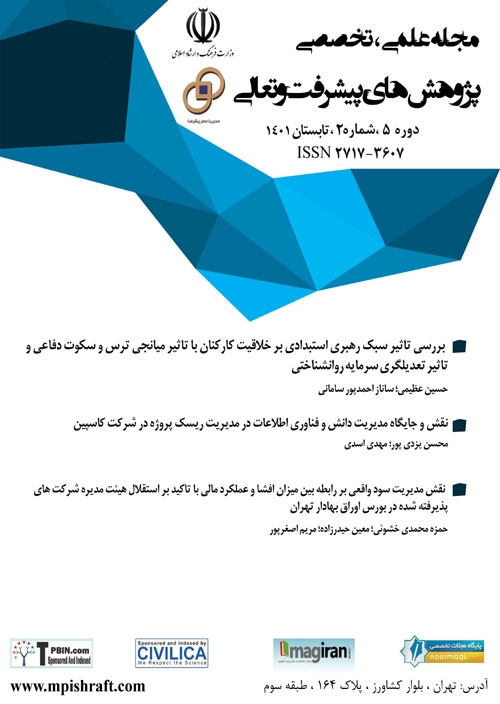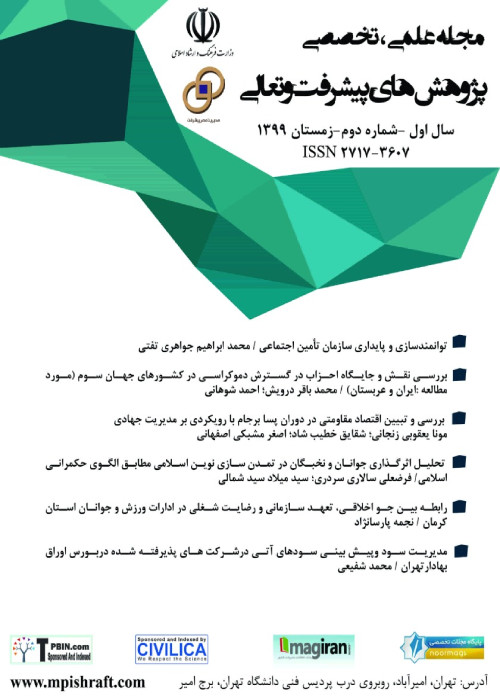فهرست مطالب

نشریه پژوهش های پیشرفت و تعالی
سال پنجم شماره 2 (تابستان 1401)
- تاریخ انتشار: 1401/06/31
- تعداد عناوین: 3
-
صفحه 1
در این پژوهش به بررسی تاثیر سبک رهبری استبدادی بر خلاقیت کارکنان با نقش میانجی ترس و سکوت دفاعی و نقش تعدیلگری سرمایه روان شناختی در شعب بانک شهر تهران پرداخته شده است. جامعه آماری این پژوهش شامل 310 نفر از کارکنان شعب بانک شهر در سطح شهر تهران می باشد که طبق فرمول کوکران انتخاب شده اند. لازم به ذکر است که روش نمونه گیری ابتدا چند مرحله ای بوده و سپس از میان مناطق سه گانه، از طریق نمونه گیری ساده به توزیع پرسشنامه تحقیق اقدام شده است. داده ها این پژوهش با استفاده از روش کتابخانه ای و پرسشنامه گردآوری شده اند. پرسشنامه مورد استفاده در این پژوهش، پرسشنامه استاندارد گو و همکاران در سال 2019 تدوین شده است و روایی و پایایی آن از طریق آزمون های مربوطه برآورد شده است. داده های این پژوهش به کمک نرم افزار LISREL مورد تجزیه و تحلیل قرار گرفته اند. نتایج تحقیق نشان داد سرمایه روان شناختی نقش تعدیلگری، ترس کارکنان و سکوت دفاعی کارکنان نقش میانجی در تاثیر رهبری استبدادی بر خلاقیت کارکنان دارند. هم چنین رهبری استبدادی بر خلاقیت، ترس کارکنان و سکوت کارکنان تاثیر مثبت دارد. ترس کارکنان و سکوت دفاعی نیز بر خلاقیت کارکنان تاثیر مثبت دارند.
کلیدواژگان: سبک رهبری استبدادی، خلاقیت کارکنان، ترس کارکنان، سکوت دفاعی، سرمایه روان شناختی -
صفحه 2
در عصر فناوری اطلاعات در دنیای پیچیده امروز هرجا سخن از پروژه های فناوری اطلاعات است،ریسک جزء جدایی ناپذیر آن است.احتمال شکست آنها همیشه بالا بوده است و در محیطهای متلاطم که سازمانها با تهدیداتی برای بقاء و عملکرد موفق مواجهند،رویکردهای مبتنی بر مدیریت ریسک میتواند در بسیاری موارد اثربخش باشد.مدیریت دانش به عنوان ساز و کار اعمال فرآیندهایی در سطح فردی،گروهی و سازمانی جهت ایجاد شرایطی که دانش و اطلاعات بتواند در زمان مناسب در اختیار افراد قرار بگیرد جایگاه مهمی در مدیریت ریسک پروژه دارد.دراین زمینه،هدف این مقاله ارایه چارچوبی برای مدیریت ریسک مبتنی برمدیریت دانش را در پروژه های فناوری اطلاعات درشرکت کاسپین تبیین کند.این تحقیق از نظر هدف کاربردی،و از لحاظ بعد طبقه بندی اهداف جزء روش توصیفی و از لحاظ ماهیت موضوع پژوهش جزء کمی قرار داردجامعه آماری این پژوهش، مدیران ونخبگان مدیریت ریسک در شرکت کاسپین است، نمونه آماری با روش نمونه گیری تصادفی ساده داده های مورد نیاز جمع آوری شد.در نهایت 120 پرسشنامه مورد تجزیه و تحلیل قرار گرفت.ابزار گردآوری اطلاعات پرسش نامه بود.روش تجزیه و تحلیل به دو صورت توصیفی و استنباطی که در قسمت توصیفی با استفاده از نمودار، درصدها، میانگین و انحراف استاندارد و همچنین در قسمت استنباطی جهت تحلیل داده ها از رگرسیون خطی ساده و برای بررسی بررسی رابطه بین متغیرها از آزمون همبستگی پیرسون استفاده شده است.نتایج نشان می دهد مدیریت دانش بر مدیریت ریسک پروژه در پروژه های شرکت کاسپین دارای تاثیر مستقیم،مثبت و معناداری می باشد .
کلیدواژگان: مدیریت دانش، فناوری اطلاعات، مدیریت ریسک پروژه -
صفحه 3
در این پژوهش به بررسی رابطه معناداری بین سطح افشا با بازده دارایی و بازده حقوق صاحبان سهام عادی و بازده دارایی و بازده حقوق صاحبان سهام تعدیل شده پرداخته شده است. همچنین به تبیین تاثیر استقلال هییت مدیره روی رابطه بین سطح افشا و بازده دارایی ها و بازده حقوق صاحبان سهام عادی و تعدیل شده اقدام شده است. برای تجزیه و تحلیل یافته های پژوهش، داده های 80 شرکت از صنایع پذیرفته شده در بورس اوراق بهادار در دوره زمانی 6 ساله بین بازه زمانی 1395 الی 1400 مورد بررسی قرار گرفته اند (بر اساس نوع داده های پانلی تعداد مشاهدات 480 سال/ شرکت بوده است). محقق برای جواب به سوال اصلی و به دنبال رسیدن به اهداف، به تفسیر یافته ها پرداخته ، سپس در مورد آزمون فرضیه ها با استفاده از مدل های رگرسیون چندمتغیره مبتنی بر داده های پانلی به قضاوت و تصریح مدل پرداخته است. در ادامه پس از توصیف آماری داده ها، به بررسی نرمال بودن متغیرها، تعیین نوع الگوهای رگرسیونی مدل ها، بررسی پیش فرض های رگرسیون و سپس به تخمین مدل های فرضیه ها پرداخته شده است. یافته ها حاکی از این است که بین سطح افشا و بازده دارایی و بازده حقوق صاحبان سهام عادی و بازده دارایی و بازده حقوق صاحبان سهام تعدیل شده رابطه معناداری وجود ندارد. همچنیناستقلال هییت مدیره نمی تواند در رابطه میان سطح افشا و بازده حقوق صاحبان سهام تعدیل شده نقش تعدیل گری ایفا نماید.
کلیدواژگان: مدیریت سود واقعی، افشا، عملکرد مالی، استقلال هیئت مدیره
-
Page 1
In this study, the effect of authoritarian leadership style on employees' creativity with the mediating role of fear and defensive silence and the moderating role of psychological capital in the branches of Tehran City Bank has been investigated. The statistical population of this study includes 310 employees of Bank Shahr branches in Tehran who have been selected according to Cochran's formula. It should be noted that the sampling method was first multi-stage and then through a simple sampling, the research questionnaire was distributed through simple sampling. The data of this research were collected using the library method and a questionnaire. The questionnaire used in this research is the standard questionnaire of Goo et al. In 2019 and its validity and reliability have been estimated through relevant tests. The data of this research have been analyzed using LISREL software. The results showed that psychological capital plays a moderating role, employees' fear and employees' defensive silence play a mediating role in the impact of authoritarian leadership on employees' creativity. Authoritarian leadership also has a positive effect on creativity, employee fear and employee silence. Employee fear and defensive silence also have a positive effect on employee creativity.
Keywords: Authoritarian leadership style, employee creativity, employee fear, defensive silence, psychological capital -
Page 2
In the age of information technology in the complex world of today, wherever IT is talking about information technology projects, risk is an integral part. The probability of their failure has always been high, and in turbulent environments where organizations face threats to successful survival and performance, approaches Risk -based management can be effective in many cases. Knowledge management as a mechanism for implementing processes at the individual, group, and organizational level has an important place in project risk management to create conditions where knowledge and information can be provided at the right time. In this regard, the purpose of this article is to provide a framework for knowledge -based risk management in IT projects in Caspian Company. This research is applied in terms of purpose, and in terms of classification of the goals is a descriptive method and in terms of the nature of the research subject. The statistical population of this study is risk management managers and managers at Caspian Company, the statistical sample was collected by simple random sampling method. Finally, 120 questionnaires were analyzed. The questionnaire was collected by a questionnaire whose reliability was obtained using Alpha Cronbach 0\/916, indicating confirmation of the questionnaire's reliability. The analysis method in both descriptive and inferential forms that are descriptive in the descriptive section using charts, percentages, mean and standard deviation, as well as in the inferential section for data analysis of simple linear regression and to investigate the relationship between variables from correlation tests Has been.
Keywords: Knowledge Management, Information technology, Project Risk Management -
Page 3
The present research is conducted analytically and quantitatively based on the financial data of the companies accepted in Tehran Stock Exchange. In this chapter, the data needed to test the research hypotheses are collected and used as a source for analysis. Descriptive and inferential statistics are used to interpret and analyze the data. In this study, a significant relationship between disclosure and asset returns has been investigated. It also explains the impact of the independence of the board on the relationship between disclosure and return on assets and the return on ordinary and adjusted equity. Based on the research methodology and process in the previous chapter, this chapter analyzes the relationships between research variables and data descriptions. To analyze the research findings, the data of 80companies from the industry accepted in the stock exchange for the period of 6 years from1390 to 1395 were investigated (based on the panel data, the number of observations was 480 years / Company has been). In order to answer the original question and to achieve the goals, the researcher has interpreted the findings. Then, on testing the hypotheses, using the multivariate regression models based on panel data, the judgment has been made. . In the following, after describing the statistical data, we examine the normality of the variables, determine the type of regression patterns of the models, review the preconditions of regression and then evaluate the models of the hypotheses.
Keywords: real profit management, Disclosure, financial performance, Independence of the Board


